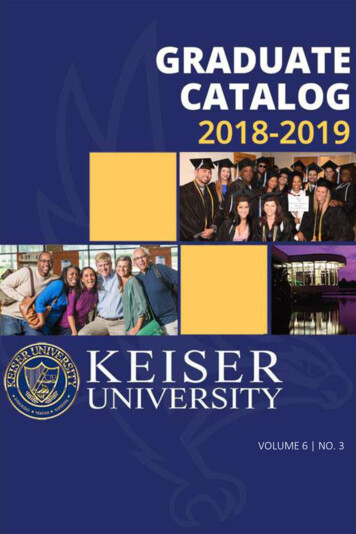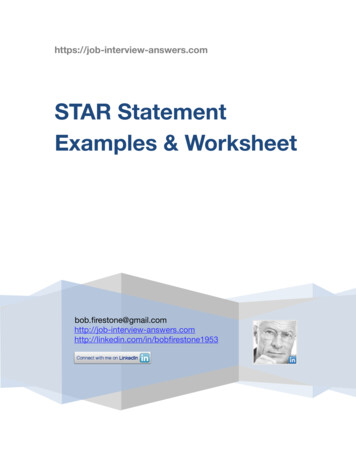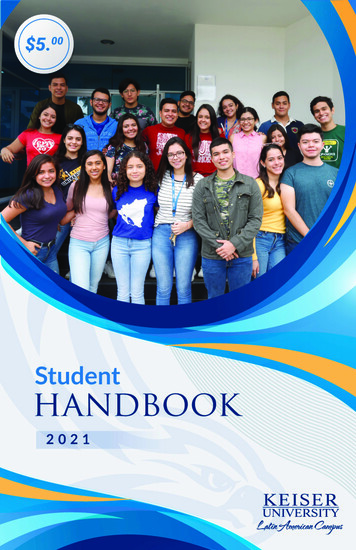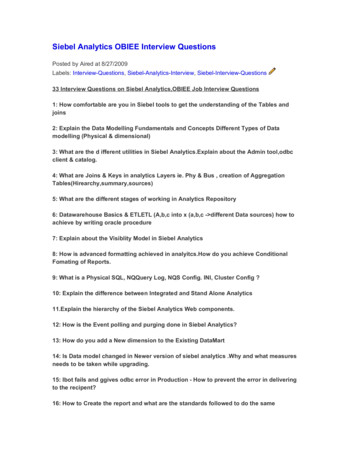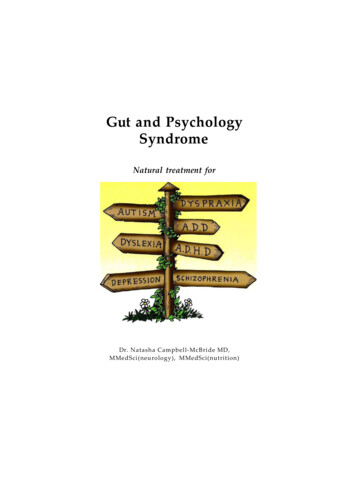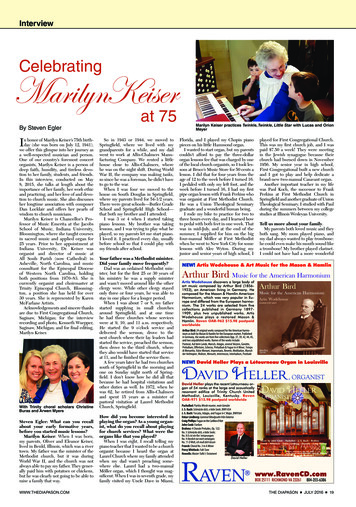
Transcription
InterviewCelebratingMarilynKeiserBy Steven EglerIn honor of Marilyn Keiser’s 75th birthday (she was born on July 12, 1941),we offer this glimpse into her journey asa well-respected musician and person.One of our country’s foremost concertorganists, Marilyn Keiser is a person ofdeep faith, humility, and tireless devotion to her family, students, and friends.In this interview, conducted on May8, 2015, she talks at length about theimportance of her family, her work ethicand practicing, and her love of and devotion to church music. She also discussesher longtime association with composerDan Locklair and offers her pearls ofwisdom to church musicians.Marilyn Keiser is Chancellor’s Professor of Music Emerita at the JacobsSchool of Music, Indiana University,Bloomington, where she taught coursesin sacred music and applied organ for25 years. Prior to her appointment atIndiana University, Dr. Keiser wasorganist and director of music atAll Souls Parish (now Cathedral) inAsheville, North Carolina, and musicconsultant for the Episcopal Dioceseof Western North Carolina, holdingboth positions from 1970–83. She iscurrently organist and choirmaster atTrinity Episcopal Church, Bloomington, a position she has held for over30 years. She is represented by KarenMcFarlane Artists.Acknowledgements and sincere thanksare due to First Congregational Church,Saginaw, Michigan; for the interviewrecording and photo, Kenneth Wuepper,Saginaw, Michigan; and for final editing,Marilyn Keiser.With Trinity choral scholars ChristineBuras and Arwen MyersSteven Egler: What can you recallabout your early formative years,before you started music lessons?Marilyn Keiser: When I was born,my parents, Oliver and Eleanor Keiser,lived in Benld, Illinois, which was a rivertown. My father was the minister of theMethodist church, but it was duringWorld War II, and the church was notalways able to pay my father. They generally paid him with potatoes or chickens,but he was clearly not going to be able toraise a family that way.WWW.THEDIAPASON.COM at 75So in 1943 or 1944, we moved toSpringfield, where we lived with mygrandparents for a while, and my dadwent to work at Allis-Chalmers Manufacturing Company. We rented a littlehouse close to Allis-Chalmers, wherehe was on the night shift. During WorldWar II, the company was making tanks,so since he was a foreman, he didn’t haveto go to the war.When I was four we moved to thehouse on South Douglas in Springfield,where my parents lived for 54-1/2 years.There were great schools—Butler GradeSchool and Springfield High School—that both my brother and I attended.I was 3 or 4 when I started takingpiano lessons. My brother was takinglessons, and I was trying to play what heplayed, so my parents let me start piano.I loved it. I practiced every day, usuallybefore school so that I could play withmy friends after school.Your father was a Methodist minister.Did your family move frequently?Dad was an ordained Methodist minister, but for the first 25 or 30 years ofhis ministry he was a supply ministerand wasn’t moved around like the otherclergy were. While other clergy stayedonly three or four years, he was able tostay in one place for a longer period.When I was about 7 or 8, my fatherstarted supplying in small churchesaround Springfield, and at one timehe had three churches whose serviceswere at 9, 10, and 11 a.m. respectively.He started the 9 o’clock service anddelivered the sermon, drove to thenext church where their lay leaders hadstarted the service, preached the sermon,then drove to the third church, wherethey also would have started that serviceat 11, and he finished the service there.A few years later he had two churchessouth of Springfield in the morning andone on Sunday night north of Springfield. I don’t know how he did all thatbecause he had hospital visitations andother duties as well. In 1972, when hewas 62, he retired from Allis-Chalmersand spent 15 years as a minister ofpastoral visitation at Laurel MethodistChurch, Springfield.Marilyn Keiser practices Twinkle, Twinkle, Little Star with Lucas and OrionMeyerFlorida, and I played my Chopin pianopieces on his little Hammond organ.I wanted to start organ, but my parentscouldn’t afford to pay the three-dollarorgan lessons fee that was charged by oneof the local church organists, so I took lessons at Bruce’s Music Store for 50 cents alesson. I did that for four years from theage of 12 to the week before I turned 16.I pedaled with only my left foot, and theweek before I turned 16, I had my firstpipe organ lesson with Frank Perkins whowas organist at First Methodist Church.He was a Union Theological Seminarygraduate and a wonderful human being.I rode my bike to practice for two tothree hours every day, and I learned howto pedal with both feet in one week. Thatwas in mid-July, and at the end of thesummer, I supplied for him on the bigfour-manual Möller at First Methodistwhen he went to New York City for somelessons with Alec Wyton. During myjunior and senior years of high school, Iplayed for First Congregational Church.This was my first church job, and I waspaid 7.50 a week! They were meetingin the Jewish synagogue because theirchurch had burned down in November1956. My senior year in high school,First Congregational built a new churchand I got to play and help dedicate abrand-new two-manual Casavant organ.Another important teacher in my lifewas Paul Koch, the successor to FrankPerkins at First Methodist Church inSpringfield and another graduate of UnionTheological Seminary. I studied with Paulduring the summers between my collegestudies at Illinois Wesleyan University.Tell us more about your family.My parents both loved music and theyboth sang. My mom played piano, andmy dad always wanted to play trombone:he could even make his mouth sound likea trombone! My brother played clarinet.I could not have had a more wonderfulHow did you become interested inplaying the organ? As a young organist, what do you recall about playingfor church services? What were theorgans like that you played?When I was eight, I recall telling mypiano teacher that I wanted to be a churchorganist because I heard the organ atLaurel Church where my family attendedwhen my dad wasn’t preaching somewhere else. Laurel had a two-manualMöller organ, which I thought was magnificent. When I was in seventh grade, myfamily visited my Uncle Dave in Miami,THE DIAPASONnJULY 2016n19
Interviewfamily. I had loving, nurturing, and supportive parents, who traveled to manyplaces over the years to hear me playconcerts and services. My mother wasa fabulous cook and a bookkeeper forSears; she managed the accounts for thelarge Sears store in Springfield alongwith six other regional stores. My dadworked two jobs most of the years I wasgrowing up. He was a great communicator, and, having grown up on a farm, hecould fix or build anything. He was awonderful athlete and had a great senseof humor (as did all of his siblings.)They are both deceased now: mydad died in 2003 at the age of 92, andmy mother died in 2012 at the age of98-1/2. They both had a wonderful senseof rhythm, and while they listened tomusic, my dad often tapped his hand orfoot. Mom would also tap her heel onthe floor. I have a wonderful video of herdoing that a month before she died.Please speak about the rest of yourfamily. Were they musical as well?I had an older brother Ralph (deceasedSeptember 2015), and we grew up inSpringfield where we lived close to ourmaternal grandparents but were only anhour away from my dad’s father and hissiblings. My dad’s mother died in 1938 soneither my brother nor I knew her, butall four of my grandparents were frommusical families.My mom’s mother played the piano forsilent movies when she was 16, and it wasthere that she met my grandfather whowas a violinist and had a band. His familyhad lots of musicians: my dad’s mother’sfamily, the Schellers, also had tons ofmusicians. One of her brothers was anorganist and a piano tuner, and my father’sfather had a beautiful bass voice. TheKeisers and the Schellers had a doublemale quartet that sang at the MethodistChurch in Mount Olive. In addition, mydad’s sisters all played piano and organ,and my mother’s first cousin played organ,so there was lots of music all around me.Did you study any other instrumentsbesides the organ and piano?I did study the violin, but I didn’treally play after eighth grade. My maternal grandfather was a great violinist andhad a beautiful German violin that Igave to a 14-year-old, a fabulous violinist, who studied at Indiana University.He had it restored to its original, beautiful sound. I actually got a recording ofit for my mom, and she was thrilled tohear Grandpa’s violin played by such atalented young man.Did you ever feel any “competition”between organ and violin?Not violin, but I did study pianoall through high school. I did a lot ofaccompanying in college and played fortwo honor recitals my senior year. I alsostudied harpsichord with Bedford Watkins at Illinois Wesleyan University.Do you recall any of the repertoirethat you learned when you first studied with Frank Perkins?I learned the Krebs/Bach Eight LittlePreludes and Fugues and the BoëllmannSuite Gothique. I just loved that firstmovement! I learned the “Dorian” Toccata of Bach and played it for the dedication of the Casavant organ at First Congregational. Another piece I learned was theCarillon in the 24 Pièces of Vierne, the onewith the big pedal part. I played it so manytimes that the sexton at Laurel MethodistChurch called me the “boom boom girl!”PIPE ORGANS OF THE RICH AND FAMOUSROLLIN SMITHROLLIN SMITH has won the 2016 NICHOLAS BESSARABOFF PRIZE, anaward presented by the AMERICAN MUSICAL INSTRUMENT SOCIETYfor the most distinguished book-length publication written in English.Largest, loudest, and most complex of musical instruments, the organ has traditionally been found in churches—from country parishes to great cathedrals—and, for centuries, small “chamber organs” were found in the homes of the elite,most often, royalty. Then, in the mid-19th century, with the application of mechanical blowing devices, organsentered the private homes of the well-to-do and professional musicians. Automatic player devices provided thosewho could afford them with a self-playing organ and the opulent mansions of the new American aristocracy offered unlimited space for extremely large instruments.Rollin Smith’s Pipe Organs of the Rich and Famous is the story of organs in more than 50 private homes. Itrecounts a time when the organ was not only a symbol of those who had arrived socially, but was considered theultimate appointment of the luxurious home, indeed, the Home Orchestra of the Twentieth Century. Included areroyalty, captains of industry, famous organists and composers, organbuilders, and those whose names are lessfamiliar, but who were patrons of the King of Instruments on a lavish scale. Well-known subjects include AndrewCarnegie, Horace Dodge, Marcel Dupré, George Eastman, Henry Ford, Henry Clay Frick, Charles Gounod, JohnHays Hammond, Robert Todd Lincoln, John D. Rockefeller, Louis Comfort Tiffany, Wm. K. Vanderbilt, Charles-MarieWidor, and Frank W. Woolworth.Designed by Len Levasseur and profusely illustrated with 300 photographs and engravings, this large-format,hard-cover book documents the work of more than 25 organbuilders in the United States, England, France, andOHS PRESS SALE 45.95Germany; stoplists of each instrument are included.IN STOCK FOR IMMEDIATE SHIPMENT! NOW CHOOSE FROM 4,367 SELECTIONS!WWW.OHSCATALOG.ORGORGAN HISTORICAL SOCIETYP.O. Box 26811 Richmond, VA 23261Telephone: (804) 353-9226Monday–Friday 9:30am–5:00pm ETcatalog@organsociety.org20nTHE DIAPASONnSHIPPINGORDER ANY TIME ONLINEUPS shipping to U.S. addresses, which werecommend, is 10.00 for your entire order.Media Mail shipping is 5.00 for your entireorder. Shipping outside U.S. is 4.50, plusthe cost of air postage, charged to your VISAor MasterCard.Preparing for a recital at Laurel UnitedMethodist Church, 1969What I remember about practicing isthat my dad would go with me after supper a couple of nights a week to sit withme while I practiced on the pipe organ atchurch. I also practiced at a music storeclose to my school.After graduation from high school,you decided to major in music at Illinois Wesleyan University in Bloomington where you studied organ withLillian McCord.I loved chemistry, math, and history inschool, but yes I decided to go into music.I auditioned at MacMurray College inJacksonville, Illinois, and Illinois Wesleyan University, but Wesleyan gave mea full tuition scholarship, so I went there.Lillian McCord was amazing. Shehad parties for all of her students aftertheir recitals. She drove us around tohear André Marchal, Marilyn Mason,Virgil Fox, and Alec Wyton. Wyton cameto Peoria my senior year, but I was notable to go due to a conflict. She took tohim my copy of his Fanfare that I waslearning for my senior recital, and heautographed it for me.Lillian was so musical and so nurturing and encouraging. She also attendeda lot of conferences and was alwayslearning new things and new repertoire.She never hesitated to suggest pieces forme to study, even though she had neverplayed them herself.IWU gave me a great education inmusic history and theory, choral literature, and contemporary music.Tell us about your time after yougraduated from Illinois WesleyanUniversity.After IWU, I went to Union Theological Seminary in New York (1963–65).Lillian McCord had gone to Union, andPaul Koch, Frank Perkins, and LewisWhikehart, my choral director at Wesleyan, had all gone to Union.Although I had been to New York Cityon a choir tour in my senior year of college, I hadn’t seen Union at that time;however, Robert Baker came to IWUmy senior year, and I auditioned for himthere. He also suggested, as did Lillian,that I study with Alec. I wrote a letter toAlec to ask if I could study with him, andhe replied saying he would be happy toaccept me as a student.There were always 35 to 40 studentsin each of the two graduate classes atUnion: two years of master’s students.You said it right: it really was a meccafor future church musicians. Daniel DayWilliams taught systematic theology.Cyril Richardson taught liturgics, andSamuel Terrien, a great Biblical scholar,was also on the faculty.After my parents drove me to NewYork City to begin my master’s degreeand before they left the city, we went overto the cathedral so they could see whereI would be taking organ lessons. Just aswe were leaving, Alec Wyton was walkingdown the driveway. We waited for himinside the choir room, and he took us upWith Trinity musicians Carolyn Craig,Katie Burk, and Brent te Veldeto the organ. I’ll always remember thisbecause when we were walking up thewinding staircase to the organ loft, Alecsaid, “Isn’t music fun?” After that, my dadquoted him all of the time.What was Alec Wyton like as ateacher?He was a great teacher. I became hisassistant later, but as a student I wasimpressed by his tremendous repertoireand how incredibly musical he was. Iheard him improvise many times at dailyservices and on Sundays, and I neverheard a trite improvisation. He had anincredible creative gift.What I remember specifically about histeaching was his concentration on musicalline. Sometimes in a Bach trio sonata he’dsay, “Let your right hand be an oboe.”He talked a lot about hand position andabout preparing your hand position. Thiswas especially helpful since I learned a lotof Messiaen during my doctoral studies. Idid the whole Pentecost Mass along withmany other Messiaen compositions. Inregard to preparing hand and feet positions, he often quoted his teacher GeorgeCunningham who would say, “Have yourfoot right over the note you need to playbefore you play it.”Alec also was very drawn to new musicand very supportive of it, and he commissioned a lot of new works. Therewere many concerts during the years Iwas in New York including Sunday afternoon concerts, and many included newmusic of various sorts. He commissionedRichard Felciano to write a piece, God ofthe Expanding Universe, for tape, organ,choir, and strobe lights.After receiving the Master of SacredMusic degree in 1965, you wereassistant organist at the RiversideChurch where you worked withFred Swann for one year. How didthis come about?After my master’s I applied for aGerman government grant to study inCologne, but during that spring I encountered Fred Swann. Evidently, RobertBaker had mentioned my name to himand that I might be interested in applyingfor the job as assistant organist at Riverside Church. Virgil Fox was leaving andFred was going to become the organist,and so I was one of three candidates whoapplied for the job. Subsequently, I wasoffered the job the day my boat ticketarrived for Germany, and that was reallya difficult decision. I remember lying facedown on the floor trying to decide what todo, and I finally decided that the thing todo was to stay in New York: I would haveopportunities to go to Germany again, butI wouldn’t have another opportunity to beFred Swann’s assistant at Riverside.The first Sunday I played was inmid-August 1965, and the preacher wasMartin Luther King, Jr.! That year waswonderful. Fred was so funny and sucha master. I learned so much by watchingJULY 2016 WWW.THEDIAPASON.COM
Marilyn Keiser with Alec Wyton at theMontreat Conference, Montreat, NorthCarolina, June 1968Receiving a red ribbon at the AbrahamLincoln Hotel, March 1950Yes. I did that for four years (1966–70),eleven rehearsals a week with the choirboys—twice a day—and Thursday nightwith the men. My first week there Alechad just been elected president of theAGO. He was there one day and gone four.We sang two psalms to Anglican chantMonday through Thursday and plainsongon Fridays. Alec transposed every chant upa third, so not only did I have to learn howto do Anglican chant—which I’d neverdone—but also I had to learn how to do itand then transpose it up a third! I workedvery hard that first week along with all ofthe choir rehearsals. It was a big learningcurve for me.With brother Ralph (left) and their parents (below) at Marilyn’s Indiana University 20th-anniversary celebration,January 2003him play that big five-manual organ.Fred had such incredible control of theorgan, and his accompanying of oratorioswas spectacular. The choir sang an oratorio every Sunday afternoon.He was gone quite a bit, and the firstSunday he was gone I was just starting theimprovisation after the offertory anthemleading into the Doxology, and RichardWeagly, who was the choir director,leaned over and said that a man was having a heart attack and just to keep playing.I had started to build the organ upreally loud and kept playing, but it wasstarting to get really loud, and I thought,“Oh, my gosh! What if this man is reallydying?” So I pulled the organ way backand just kept playing: it seemed like aneternity. Eventually, they were able toget him out on a stretcher, and he didnot die. That was a memorable moment!Did you have any other church positions while you were in New YorkCity?During the two years I was working on my master’s degree, I did havea church job at a Methodist church inBergenfield, New Jersey. That was myfirst experience working with a children’s choir. I also played the organ anddirected the adult choir.After one year at Riverside Church,you were appointed associate organistand choirmaster of the Cathedral ofSt. John the Divine where you servedfor four years. You were now a colleague of your teacher, Alec Wyton.Eugene Hancock was leaving St. Johnthe Divine, so Alec asked me to becomehis associate at the end of that summer.He thought that they would not acknowledge that I was a woman and, instead,put M. J. Keiser on the masthead of thecathedral bulletin, but they did in factprint my name as Marilyn Keiser. When Ifirst went there, I even had to wear a blackbeanie on my head during the service.You might as well have been calledco-organist and choirmaster.Yes. He was gone a lot during his timeas president but particularly that first year.In 1970, you moved to Asheville, NorthCarolina. Tell us about the responsibilities there in those positions.In my fourth year at St. John theDivine, I met the Reverend Alex Viola—at Alec Wyton’s recommendation—inNew York. He had just moved to Asheville as the associate rector at All SoulsEpiscopal Church and said they werelooking for a new musician. I had alsolooked at a couple of other options, buthe persuaded me to go to Asheville toaudition. I was really interested in this,because in addition, Alex had gone to thediocesan foundation to ask for a threeyear grant for someone to travel aroundthe diocese (Diocese of Western NorthCarolina) to work with small churches.Playing first chair violin in the Butler Grade School orchestra, spring 1955That summer, I was the first personhired by an Episcopal diocese to serveas a music consultant and work withsmall churches throughout the diocese.So I had a joint appointment: I workedthree-quarter time at the church andone-quarter time for the Diocese ofWestern North Carolina, and I traveledto the small churches at their invitation.When I went to All Souls, the choirwas pretty small. I recall there weremaybe twelve people, whose average agewas about 68. They did, however, havea few paid soloists—one student andsome adults— and over the course of theyears, we established a music committeethat was instrumental in establishing achoral scholar program similar to whata colleague of mine had instituted inMilwaukee. We then brought in twostudents from Mars Hill College—nowUniversity—who received a 50 stipendeach semester. After that, we soon hadfour and then eight by the time I leftin 1983. The choral scholars with theiryoung voices transformed the choir.My diocesan work turned out to bethe topic of my doctoral dissertation atUnion, which was called Singing the Liturgy in Small Communities: Pilot Projectin the Diocese of Western North Carolina.Describe your work as consultantto the Diocese of Western NorthCarolina.I worked with choirs and organists aswell as with clergy groups. I also workedwith children’s choirs and had a children’s choir festival and acolyte festival,but most of what I did was leading congregational hymn sings. Of course, thesewere the years prior to The Hymnal1982, and I led many hymn sings.All Souls Parish—now Cathedral ofthe Diocese of Western North Carolinaas of 1995—was the church built byGeorge Vanderbilt and had a fine musictradition. F. Flaxington Harker was oneof my predecessors there. Clem Sandresky, who later became the head ofthe School of the Arts in Winston-Salem,North Carolina, was also a predecessor ofmine, and in the early years he was alsothe organist at the Grove Park Inn, whichhad a big organ no longer in existence.What sorts of music did you performwhile at All Souls?I had great support from the clergy,and in fact, I have had that in every position I’ve ever held. Neil Zabriskie was afantastic rector and very supportive during my years there. We did Noye’s Fluddeby Benjamin Britten twice: the first timewas for the 75th anniversary celebrationof the church. We involved 200 people init one way or another and had kids fromall over the city. We also had a team ofabout 20 women who made the mostfabulous costumes.We also presented Menotti’s Amahland the Night Visitors twice. When wedid Amahl, I actually played the organand had a small orchestra around me: Iplayed and conducted from the organ.When we performed Noye’s Fludde, wehad a full orchestra, so I stood in the pulpit in order to conduct the congregation.AN ORGAN FOR A PRIVATE CHAPELIt is not often that a private chapel is built these days. We have completed an instrument for such a chapel. It is a one manual and pedal instrument and has some unusualelements. Firstly, the organ has a traditional old English feature of including a GG andAA below bottom C, with a split C# key so that AA and C# can be played. Most stopsare divided at middle c. The client also requested a thunder pedal, nightingale and awind-operated cymbelstern. But the most unusual request was for a bear to be hiddenin the case and to emerge when a stop was pulled, making a bear-like sound. This isoperated pneumatically and can be viewed at https://youtu.be/iusa0miwHb0. Theorgan has a fine walnut case with gilded cast bronze pipe-shades and decorated keys. St Peter’s Square - London E 2 7AF - England [t] 44 (0) 20 7739 4747 - [f] 44 (0) 20 7729 4718 [e] ManderUK@mander-organs.comMANDER ORGANSwww.mander-organs.comTimes have changed, haven’t they?WWW.THEDIAPASON.COM THE DIAPASONnJULY 2016n21
InterviewWe commissioned and premiered thechildren’s opera Genesis (1971) fromMalcolm Williamson and gave the firstperformance of his opera The Red Sea(1972). We did the first performance ofAlec’s opera Journey with Jonah. In 1980we did a performance with full orchestra of Mendelsohn’s Elijah and had a“Mostly Mozart” concert one year, anda Haydn concert another year. Then forsix or seven years we presented a procession of Advent Lessons and Carols, anidea that I had gotten from Jim Litton atPrinceton. I always had wonderful support from the parish and the community.You also taught at the University ofNorth Carolina at Asheville duringthis time.I taught at Brevard College my firstthree years in Asheville, and then duringthe last two years of my tenure in AshevilleI taught at UNC Asheville. During thosetwo years, I conducted the communitychorus of about 75 people and performedthe Fauré Requiem the first year and theHonegger King David the second year.I recall starting to conduct the Fauré,and my baton hit the music rack andflipped over into the French horn section. I just kept conducting and the hornplayer handed the baton back to me!How do you balance being a performer, a church musician, and aneducator?I have had the best of all worlds. Iused to think when I was driving to IUthat so many people work in factories orclean houses and shovel coal, and I go towork and make music all day long. Whata gift to be able to spend your life makingmusic: I cannot imagine a more fulfillingand wonderful way to spend your life.I first joined Phyllis Stringham’smanagement and was with her for just acouple of years. Then Karen McFarlaneand Ralph McFarlane began their ownmanagement. I had met Karen when Iwas in St. Louis during the summer of1963. Karen was also a student of FrankPerkins during her undergraduate studies at Lindenwood College.So this was before the Murtagh years?Yes. Karen and Ralph had a management which, I believe, was calledMcFarlane Artists. The summer beforeI moved to New York I stayed in FrankPerkins’s house with another Lindenwood graduate, Linda Street, who wasalso going to attend Union Seminary thatfall. She and Karen were good friends, sothis is how I got to know Karen.Karen then moved to New York atthe end of my year with Fred Swann atRiverside, and she became Fred’s secretary. We stayed in contact for a longtime and became good friends, so I waswith her management for a number ofyears. When Lilian Murtagh became ill,Karen of course, being at Riverside withFred and Fred being in the Murtaugh“stable” as they called it, got to knowLilian and eventually took over themanagement in 1976.Your performing career has takenyou across the U. S. and abroad.I’ve performed a lot in this country, butI haven’t traveled abroad too much. I’veplayed a couple of times in England andonce in Paris and Brazil and Singapore.Three years ago, I went to China with theIndianapolis Symphonic Chorus where Iplayed the Brahms Requiem for them onthe organ at the Shanghai Oriental ArtsCenter on two hours’ practice. It was themost nerve-racking thing I’ve ever done!There were 1,100 people, even sittingbehind the choir. It was jam-packed!Since the Brahms ends so quietly, Ioffered to play the Widor Toccata as anencore. It was well received.What do you like about being a concert organist?I love playing beautiful organs, and Ilove finding beautiful sounds on thoseorgans. I also love learning the geography of every organ, which is so uniqueand very challenging. Some people lovecrossword puzzles: I love getting to knownew instruments. I also enjoy seeing former students and classmates and friendsfrom over the years.What’s the schedule like in a day ofMarilyn Keiser’s life?When I was teaching I got up at 5o’clock every morning and walked, hadbreakfast, dressed, said my prayers, andI always tried to get to school by at least7:30 a.m. so I could get a parking place.I’d teach sometimes five or six hours withmaybe a 15 to 20-minute break beforemy classes began in the afternoon.I always try to practice every day. Oneof the gifts I got from my parents—notjust the gift of interest in and ear formusic—was discipline. In my parents,I saw great discipline and the ability tokeep working at something. My motherwas a fantastic seamstress and quilter.She also crocheted, and with a projectalmost complete, she’d see where shedropped a stitch, take it up and go backand repair that spot. Her stitches andquilts are absolutely exquisite.I think both Ralph and I inheritedthe energy and the will to work hard atthings. I admit that for me practicinghas never been a burden: it is somethingthat I just love to do. I have always lovedlearning new music and still do.In 1983 you were appointed to thefaculty at Indiana University whereyou served until 2008, and in addition to applied organ, you taughtclasses as well.I was brought to Indiana University todevelop the church music curriculum.I added to the choral literature coursesthat Oswald Ragatz had created. Hetaught two choral literature courses: onein anthems and motets and the other onein large forms.I didn’t have any of his notes, so I justdeveloped those courses on my own. Iadded courses in hymnody and organimprovisation, and I developed a churchmusic practicum where we talked abouthymn playing, conducting from the console, anthem repertoire, wedding music,handbell
Bloomington, where she taught courses in sacred music and applied organ for 25 years. Prior to her appointment at Indiana University, Dr. Keiser was organist and director of music at All Souls Parish (now Cathedral) in Asheville, North Carolina, and music consultant for the Episcopal Diocese of Western North Carolina, holding
